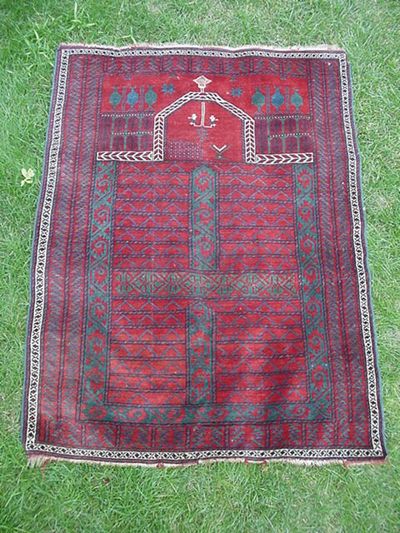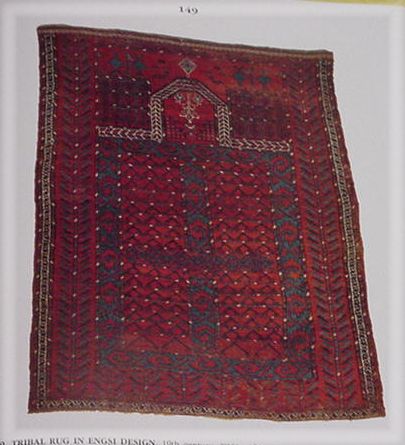Posted by Mark Traxler on 08-26-2002 11:19 AM:
Kirman "Engsi"
Greetings: What a wonderful display of Turkoman engsi types! I am always
amazed at the depth of the creativity of textile artists. It is an outpouring
from some enduring reservoir. I will attempt to attach jpgs of a Persian engsi
design form. According to Eiland this form originates in the Kirman district of
Persia. I know of only three of this type, making them interesting enough to
mention in a thread. The Turkoman form is "augmented" with the addition of
formal objects: a Koran stand, a mosque lamp, cypress trees, and "shield"
forms. Here is an example from my collection. Knotted with a semi-depressed
warp on wool foundation at about 90 knots per inch, the piece is about 4'X6'.

It was Kasra Masserat, from Tucson, AZ, who introduced
this abberant form to Mr. Barry O'Connell's readership. Kasra posted an example
of his own and some interesting discussion followed. Another reader made
reference to Eiland's book, Rugs From Pacific Collections with this example,
which Eiland attributes to the Kirman district.

I find myself wondering about the connection between this
"Persian" engsi form and its original Turkoman forebearer. The Persian examples
probably do not date much earlier than 1900, but they raise interesting
questions. It is a matter of conjecture what the tribal Persian weavers had in
mind by introducing a mosque lamp into the arch space as well as the other
representational elements. I welcome more erudite analysis. Thank you. Mark
Traxler
Posted by Steve Price on 08-26-2002 02:10 PM:
Hi Mark,
If it's from Kerman, and if Eiland says that's where
it's from, it probably is, then its relationship to ensis is because buyers in
the west found the ensi design attractive. There were enormous numbers of Tekke
ensis produced for export in the latter part of the 19th century.
As far
as I know, Kerman isn't a place where you'd find Turkmen (or Turkwomen) doing
their traditional weavings. So, these are rugs made locally from designs most
likely done by professional designers and given to the weavers for production.
The mihrab and lamp were probably intended to add to the exotic, Asian
character, and to give it a prayer rug flavor. It may be significant that ensis
were thought to be prayer rugs for quite awhile.
The one in Eiland's
book looks like it was made from a cartoon. The corners resolve, the columns
line up perfectly with the motifs in the lower panel and are horizontally
symmetric. Yours looks as though it was done more or less freehand - the lower
border motifs don't form a symmetric pattern.
Regards,
Steve
Price
Posted by Mark Traxler on 08-26-2002 04:12 PM:
Kerman "engsi"
Thank you, Steve: I agree this rug smacks of commercial origins. Eiland
points out that it certainly has no "historical" root. However, there are none
of these rugs around. Despite my obsessive searching of ebay for the occasional
"find" [remember that a variable schedule of reinforcement is the most
rewarding] I have not encountered even one of these - in any condition. There
is enough consistency between Kasra's piece [which can be viewed on Barry's
discussion board] and these two that one can posit a "form." What I wonder is,
did the piece have some ethnographic significance to the weaver and her culture
or was this "form" a local effort over a period of years to produe a commercial
profit?
When I first looked at the piece I knew it wasn't Turkoman.
However, what impressed me was the somberness of the rug. It has a funerary
quality, with the cypress trees and "shield" forms set off by columns. So I
wondered if it might be a mazarlik. Is that a possibility? Did rural Persians
weave textiles for funerary purposes?
I've always liked this piece
because of its uniqueness. There are just so few of the type around. It would
be nice if one of the readers would offer some "evidence" about the nature, use
or origin of this little "group." In the long run, Steve, we may be right. The
rug was a small-scale commercial effort that never really got off the ground.
However, maybe there's more to the story.
Mark Traxler
Posted by Steve Price on 08-26-2002 05:15 PM:
Hi Mark,
I'd be astonished if there is a local cultural tradition
in the Kerman area that involves these clearly Turkmenoid rugs, although I've
been astonished before.
I don't know whether funerary rugs were used in
the area, although some of our other readers might be able to answer that one.
Regards,
Steve Price
Posted by Marvin Amstey on
08-27-2002 10:50 AM:
Don't forget that the Afshar are Turkoman, and the reside in the Kirman
area. Their weaving tradition has the same heritage as the usual Turkoman
names. This "engsi" could be an Afshar weaving (I haven't seen its
construction), and while made for trade (aren't all rugs?), is based on some
long past tradition.
Best regards.
Posted by Steve Price on
08-27-2002 11:00 AM:
Hi Marvin,
I don't think all rugs were made for trade, although
most of the ones that are in western hands today were. Most (but not all)
tribal weaving before, say, 1875 was done for local use.
I wasn't aware
that the Afshar were Turkmen. Just two years ago I was given a beautiful Afshar
sofreh as a gift from a Kurdish friend, and he told me the Afshars are
Kurds.
So, now in just two short years, I've learned that Afshars are
Kurds and that Afshars are Turkmen. Before the list gets much longer, perhaps
we can begin naming the groups to which the Afshar don't
belong.

Regards,
Steve Price
Posted
by Marvin Amstey on 08-27-2002 02:55 PM:
From Opie's book, Afshar's are Turkic speaking. According to Brian
McDonald, the Afshar are traceable to a clan of the Turkic Oghuz who left the
plains of Turkestan and moved into Persia in the 12th c.; they were forceably
moved to the Kirman area in the 16th c. So all you Turkoman collectors out
there can add this tribe to your repertoire and increase the color in your
lives.
Best regards.
Posted by Stephen Louw on 08-31-2002 05:44
AM:
Like Steve, I tend to assume the rug was woven for trade-commercial
reasons, unless proven otherwise. A well known Iranian manufacturer based in
the Fars region has a product range of very similiar turkmen engsi adapted
design's, although woven in silk!
Thanks to Johnfor a great
Salon
Stephen

